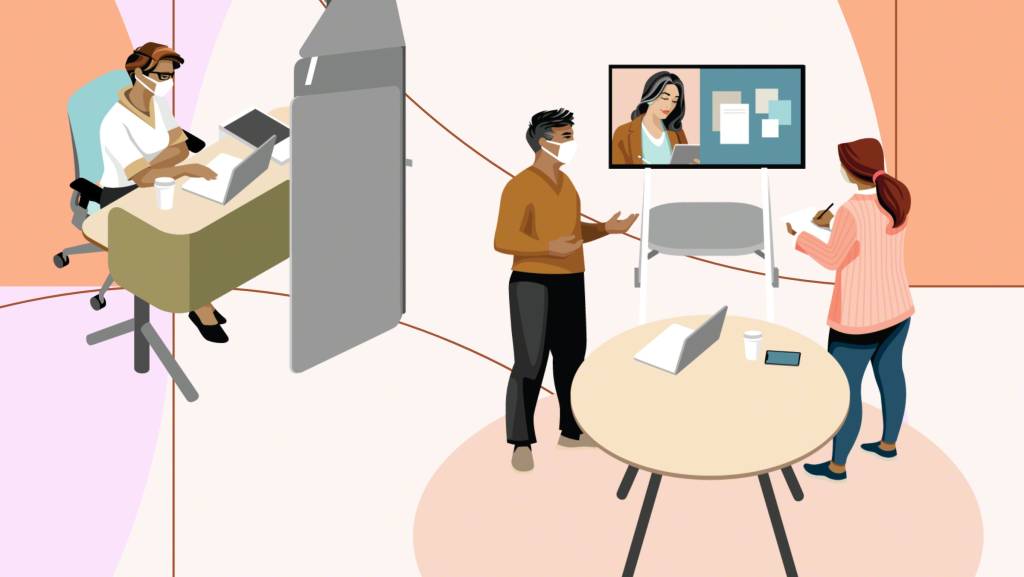Real Questions, Real Answers About Hybrid Work
Seventy-two percent of global organizations are planning some degree of hybrid work — meaning some people will work in the office and some will work at home or in a third place. But, a hybrid approach is complicated. No one has done this before at this scale. Leading organizations are asking very real questions about how to successfully implement hybrid work and we wanted to offer some real answers by drawing on our research, our experience and our audience.
The Steelcase Global Return to Workplace Study in March 2021 gives us an idea of what global leaders are planning:
– 58% will increase real estate in 2022, 29% will maintain, 13% will decrease
– 54% plan to run significant pilots to inform workplace strategy
– 69% plan to increase spaces for general collaboration
– 68% plan to increase spaces for hybrid collaboration
– 76% in the U.S. will rely on user or user and in-room tech to collaborate
During the webinar more than 1,100 people joined us for a live, interactive discussion about hybrid work (which you can now watch on demand). Our live audience answered poll questions alongside a Steelcase panel that touched on all aspects of hybrid work — people, place, process and technology. 360 Editor-in-Chief Chris Congdon moderated the discussion with Chief Information Officer Steve Miller, Vice President of Workplace Innovation + Brand Management Gale Moutrey, and Senior Consultant with Applied Research + Consulting Rich Benoit.

Chris Congdon: How do you decide who works from home and how often?
Rich Benoit: It’s a complex issue. We think about it in three parts: What does the organization need for the business, what do teams need to do their best work and what do individuals prefer? This past year has changed people’s perceptions about the office. Some feel they can be productive at home, but others feel isolated or overwhelmed. So, understanding employees’ motivations is important. Consider how teams will function if they aren’t sitting together? And think about what the organization needs from people to make sure the business is moving forward. We anticipate some sort of social contract between the organization and the individual because leaving it up to individuals alone to decide when they come in and how often may not be what’s best for the business.
“The fluidity that all of us go through between individual work, shifting to a sidebar conversation or moving to something more formally scheduled isn’t likely to change. So organizations need to be much more intentional about supporting how we move from one work mode to another.”
Rich BenoitApplied Research + Consulting, Senior Consultant
CC: How are organizations you talk to planning to bring people back to the office?
RB: Understanding how people get their work done is one of those obscure things that companies don’t always have a good handle on. The idea that we’re only going to come into the office to collaborate doesn’t really make a lot of sense because that’s not how we schedule our days. The fluidity that all of us go through between individual work, shifting to a sidebar conversation or moving to something more formally scheduled isn’t likely to change. So organizations need to be much more intentional about supporting how we move from one work mode to another. Just because I come into the office two days a week, doesn’t mean I only need a touchdown space because I’m there “part-time.” I still need access to privacy, the ability to find my colleagues and to be able to work in my rhythm.
CC: How is Steelcase approaching the return to the workplace?
Gale Moutrey: We believe it’s important to have a construct or a plan. For us, that plan is in three parts — invite, encourage and expect. We’ve already begun to invite essential workers back. As soon as we’re able to in different parts of the world, we’re encouraging employees to come back and experiment with us. And that’s really key, they learn along with us, and we’re able to share what we learn with our customers. The third phase is expect. In many respects, we’ve always been hybrid. People have always had an opportunity to work other places when they need to. But we are a business that fundamentally believes in people being together to collaborate, and as much as we can be shoulder-to-shoulder — that is what we want to do. Of course, we’ll continue to support how we work with remote participants as well.
CC: How can organizations maintain culture in a hybrid work model?
Steve Miller: I’ve had people say working from home is like interacting with each other looking through a keyhole. You see a little part of what’s happening but not what’s going on all around you. We’re missing all those things that happen outside your field of view that help us perform well and that’s where a lot of culture happens.
RB: We build culture through the rituals we go through every day to build our networks, see our friends and socialize ideas. Virtually, we don’t have all of those same ceremonies. Consider this: Can you have culture without coffee? You might be able to bring people together virtually to work on a problem, but you don’t get people bumping into each other, coming across diverse perspectives or walking around and seeing what’s going on in another meeting. So leaders have to be far more intentional about how they bring people together and provide continued awareness in a hybrid model.
“We started to think about how to use underutilized cafe space to create a magnet so people coming back would want to be there. And the more they are there, the more others will want to be there.”
Gale MoutreyWorkplace Innovation + Brand Management, Vice President
CC: What should organizations think about doing first in the workplace as they plan for people to return?
GM: We began thinking about this when we had people start returning over the summer. People who went back said they couldn’t wait because they missed the energy of being with others. But when they got back, they said it felt “sad.” The spaces they were returning to had a lot of safety measures in place. In our cafe, for example, every other table and chair were removed. Then, we had an “aha” moment. We started to think about how to use underutilized cafe space to create a magnet so people coming back would want to be there. And the more they are there, the more others will want to be there.
So we’ve been working with designers to set up spaces for people to do numerous things — collaborate, socialize and still be distanced with access to the tools they need to get work done. Then, we began working with Compass, a food services group and division of Eurest, on friction-free food delivery and pickup options. We’re bringing together food and furniture in hardworking “social hubs.” We’re prototyping ideas now and everything is very flexible. Elements can move throughout the campus as needs change.
CC: How can organizations accommodate a wider and more broad use of technology moving forward?
SM: When you think about technology and people’s experiences with it, it’s a little like thinking about wellbeing. We’ve all had that sinking feeling when technology isn’t working as it should. What’s happened during the pandemic is that the equation for wellbeing has changed. When employees spend a lot of time in the office, there are some obvious ways to achieve wellbeing. In a hybrid mode, people are changing what technology they use and where they use it. We break it down into four key areas:
- Care – How do you support employees and their technology needs?
- Connect – When people bring in a device, how does it connect and use the technology in your space?
- Control – When you have a mix of technologies, there needs to be a plan for managing them (if people bring monitors home, for example)?
- Coverage – People are going to be doing video calls in places they weren’t doing them before. How do you ensure network coverage so these work everywhere possible?
Traditionally, companies had rooms set up with all the equipment you needed configured perfectly for a great video call. But now people will be doing these calls more often and in more places. So, we need to think like a director — lights, camera, audio, and content. How do you make it so the elements needed for a great connection between people are present in more places? That’s where we think about acoustic barriers, visual backgrounds and dialed in lighting so that you have consistently great video calls in more places.
CC: How do you design spaces to support hybrid collaboration and help people in the office and away from the office work together?
GM: Figuring out how to braid these digital and physical experiences together is probably the wicked problem of our time. We have to think about this across a variety of collaboration moments between individuals, small and large groups. And we need to design for different types of collaboration as well. Are you sharing information or trying to generate new ideas? We need a greater range of solutions going forward. When we think about space, we think about three key factors:
- Equity – How do we make this a great experience for people in the room and for people who are remote? Mobility is key. People in the room should be able to move around, and if remote participants are on a screen, they can be moved around as well. And we want to keep everyone eye-to-eye as much as possible. Angled conference tables help remote working team members see everyone in the space and allow for those in the space to see past each other to the screen.
- Engagement – How can we create spaces that allow people to be as engaged as possible? When you move your body, your brain perks up too. They should have the tools they need in the space — whiteboards, places to hang up artifacts and digital tools that allow for the co-creation of content and for content to be shared easily.
- Ease – How do you make the space and technology really easy to work with? You should be able to walk in and join a session as simply as possible.
RB: I would offer a fourth E, which is etiquette. Everyone has to be very intentional about learning, recognizing and accepting new behaviors. If you’re expecting people to do one thing and instead they do something else, you’ll be disappointed. For example, people should always introduce themselves if they don’t know each other. If you’re trying to create new ideas, turning your camera on is so important. Each team is going to really want to think about what their rules of etiquette are going to be.
CC: We’d like to give everyone a chance to offer a final thought for our conversation about hybrid work.
RB: Organizations will want to make sure there are clear expectations moving forward. We want to acknowledge the autonomy and flexibility employees are looking for, but we also want to have some guardrails. Too much choice can be overwhelming and stifling. Organizations should have some parameters around expectations and should consider creating a social contract with their employees. That’s one of the most meaningful things an organization can do.
SM: We all need to be careful and not do a ribbon cutting on this transformation — nothing will ever be final. We are going to iterate our way through this and learn as we go. There’s not going to be a point where we say we’re done. It’s going to be an extended effort.
GM: Culture, innovation and growth are exactly the things leaders globally are worried about. That’s why contrary to what we read a year ago about the office going away, the opposite has actually happened. Whether or not our future workplace is bigger, the same size or smaller, or is made up of an ecosystem that includes home, the places where we come together matter more now than they ever did because we have a year to make up for.
POLL RESULTS
Our webinar audience answered poll questions throughout the live event. Here’s what they said:
Q: Is your organization considering a hybrid work strategy?
82% Yes
4% No
14% Undecided
Q: What is your organization’s main rationale for planning a hybrid approach?
40% Employee safety and wellbeing
26% Our employees expect it
17% Talent attraction and retention
9% Saving on real estate costs
8% Other
Q: How will your company implement remote work practices?
11% Employees decide daily
10% Employees choose consistent days
20% Teams choose consistent days
14% Employees and teams are instructed
7% Other
37% Undecided
Q: What is your organization’s biggest worry about hybrid work?
34% Maintaining company culture
33% Decreasing engagement & productivity
12% Harder to innovate and grow
6% Corporate responsibility for work from home
5% Supporting employee wellbeing
5% Other
4% I’m not worried about anything
1% We’re not planning a hybrid strategy
Q: Of your company’s employee population, how do you expect people will work when they can return to the office?
10% – Most people will work in the office
28% – 75% in the office, 25% out of the office
43% – 50% in the office, 50% out of the office
18% – 25% in the office, 75% out of the office
1% – Most people will work at home
Q: Do you expect your organization to change how you allocate assigned and unassigned workspace?
11% Yes – more assigned
46% Yes – more unassigned
20% Planning to experiment
13% No
10% Undecided
 Rich Benoit is a Senior Consultant with the Steelcase Applied Research + Consulting team. He has over 10 years of experience of leveraging research and insights to help organizations create highly effective workplaces that align with their culture and business strategies.
Rich Benoit is a Senior Consultant with the Steelcase Applied Research + Consulting team. He has over 10 years of experience of leveraging research and insights to help organizations create highly effective workplaces that align with their culture and business strategies.
 Steve Miller is Chief Information Officer for Steelcase and has spent the last 21 years at the intersection of technology + work. Most recently, Steve has focused on how Agile development practices and the digital transformation of businesses is impacting the culture, practices, and environmental needs of people at work.
Steve Miller is Chief Information Officer for Steelcase and has spent the last 21 years at the intersection of technology + work. Most recently, Steve has focused on how Agile development practices and the digital transformation of businesses is impacting the culture, practices, and environmental needs of people at work.
 Gale Moutrey is global vice president, Workplace Innovation + Brand Management for the Steelcase family of brands. In her role Gale travels the world, physically and virtually, speaking with customers, design professionals and leading organizations about the changing nature of work and the important role of the workplace.
Gale Moutrey is global vice president, Workplace Innovation + Brand Management for the Steelcase family of brands. In her role Gale travels the world, physically and virtually, speaking with customers, design professionals and leading organizations about the changing nature of work and the important role of the workplace.


